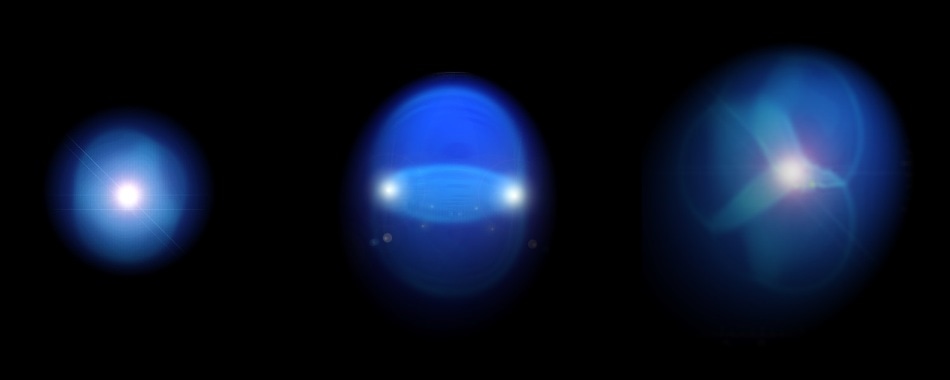Dec 11 2018
Tiny droplets of the ultra-hot matter with which the early universe was filled have been developed by scientists, forming three unique shapes and sizes: ellipses, circles, and triangles.
 Visualization of expanding drops of quark-gluon plasmas in three geometric shapes. (Image credit: Javier Orjuela Koop)
Visualization of expanding drops of quark-gluon plasmas in three geometric shapes. (Image credit: Javier Orjuela Koop)
The research, reported in Nature Physics on December 10th, 2018, arises from the study of an international group of researchers and focuses on a liquid-like state of matter known as a quark-gluon plasma. According to physicists, the entire universe was filled with this matter during the first few microseconds after the Big Bang when the universe was still extremely hot for particles to combine to produce atoms.
CU Boulder Professor Jamie Nagle and collaborators at Vanderbilt University worked together on the experiment called PHENIX and employed a massive collider at Brookhaven National Laboratory in Upton, New York, to recreate that plasma. In a series of investigations, the scientists smashed packets of protons and neutrons in distinctive combinations into considerably bigger atomic nuclei.
They found that when conditions were carefully controlled, they were able to produce quark-gluon plasma droplets that expanded to form three distinct geometric patterns.
The outcomes offer the strongest evidence until now that such minuscule drops act like a fluid. Nagle stated that this is something that researchers had earlier regarded to be impossible.
Our experimental result has brought us much closer to answering the question of what is the smallest amount of early universe matter that can exist.
Jamie Nagle, Professor, Department of Physics, CU Boulder.
He put forward this set of experiments in 2014 along with his collaborators.
Perfect fluid
Initially, researchers started analyzing such matter at Brookhaven’s Relativistic Heavy Ion Collider (RHIC) in 2000. The heavy nuclei of gold atoms were crashed together, generating temperatures of trillions of degrees Celsius. In the ensuing boil, quarks and gluons—the subatomic particles that form all protons and neutrons—escaped from their atomic chains and flowed almost freely.
It is likely that such a short-lasting state of matter, which according to theorists mimics conditions observed right after the Big Bang, behaves similar to a “perfect fluid,” stated Paul Romatschke from CU Boulder, who is an associate professor in physics.
If you could have a bottle of this liquid on your desk and you were to tip it over and have it flow around an obstacle, it would do so with almost no friction.
Paul Romatschke, Associate Professor in Physics, CU Boulder.
Many years later, theorists were shocked by the results of a set of experiments performed at the Large Hadron Collider in Geneva, Switzerland: they noted that they seemed to have developed a quark-gluon plasma not by slamming together two atoms, but by merely crashing together two protons.
That was astonishing since it was assumed by most researchers that single protons do not have the ability to deliver adequate energy to create anything that could flow like a fluid.
Liquid ripples
In 2014, Nagle, Romatschke, and their coworkers formulated a method for testing the concept: if such tiny droplets were behaving similar to liquids, then they should hold their shape.
Imagine that you have two droplets that are expanding into a vacuum. If the two droplets are really close together, then as they’re expanding out, they run into each other and push against each other, and that’s what creates this pattern.
Jamie Nagle, Professor, Department of Physics, CU Boulder.
Put differently, if two stones are tossed into a pond close together, the ripples from those impacts will flow into each other, giving rise to a pattern that looks like an ellipse. The same could hold good if a proton-neutron pair, known as a deuteron, is smashed into something bigger, Nagle and Romatschke reasoned. Similarly, a proton-proton-neutron trio, also called a helium-3 atom, might expand out into something analogous to a triangle.
This is precisely what the PHENIX experiment unearthed: short-lasting ellipses were formed by collisions of deuterons, triangles were formed by helium-3 atoms, and a single proton exploded in the shape of a circle.
According to the researchers, the outcomes could assist theorists to gain better insights into how the original quark-gluon plasma of the universe cooled over milliseconds, giving rise to the first atoms in existence.
Currently, a next-generation experiment known as sPHENIX is being developed, with leadership from scientists at CU Boulder, to investigate quark-gluon plasmas at even smaller length scales.